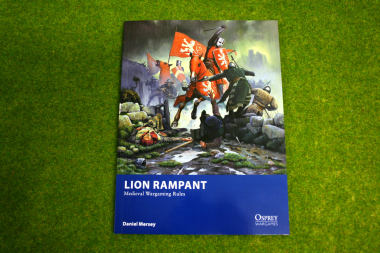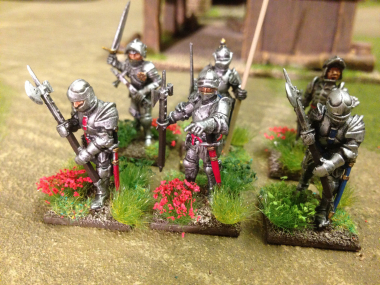 I mentioned in my blog earlier that I had signed up for the Wargames Illustrated Magazine’s Lion Rampant day, to be held on 31st January 2015. Although it seems some way off, I thought that I better start putting my retinue together and of course practicing the game. As I am somewhat focused on collecting English Armies (and their Allies!), I thought that I would start with a typical English Warband. In the LR rules this breaks down to: a unit of 6 foot men at arms; a unit of 12 ‘expert’ foot sergeants and two units of 12 ‘expert’ Bowmen; a total of 42 figures to assemble and paint.
I mentioned in my blog earlier that I had signed up for the Wargames Illustrated Magazine’s Lion Rampant day, to be held on 31st January 2015. Although it seems some way off, I thought that I better start putting my retinue together and of course practicing the game. As I am somewhat focused on collecting English Armies (and their Allies!), I thought that I would start with a typical English Warband. In the LR rules this breaks down to: a unit of 6 foot men at arms; a unit of 12 ‘expert’ foot sergeants and two units of 12 ‘expert’ Bowmen; a total of 42 figures to assemble and paint.
I could save a bit of painting time by having two units of 6 foot men at arms but this will make the army quite fragile. However, in the short term it will speed the process of having my own retinue finished. The beauty of the English Retinue is that I think that I will be able to build most of the figures using the Perry’s Wars of The Roses Plastic boxed set, which has 40 figures, a good mix of which are either archers or Bill men (foot sergeants). So for an outlay of £12 for the rules and £20 for the figures, I’m in the game!
For those of you not familiar with Lion Rampant, it is one of the Osprey Wargames mini rules, written by Daniel Mersey. It’s one of those clever rules sets that does what it says, it really is straight forward and simple to learn, easy to play and has enough subtlety to keep players engaged. As I have previously noted, this type of skirmish game is a great way to explore a historical genre before you pile in and build a huge army. Even better, the small war bands allow you to mix & match different troop types. So if my English Army doesn’t work for me or if I fancy a change, it wont take too much effort to produce, say, a Templar war retinue.
The game itself is a bit like Saga Rules, but without the Saga board – all the action takes place on the table and combat is resolved quickly by rolling either 6 or 12 dice. A simple attack & defence mechanic determines how many casualties are inflicted and then it’s down to morale – which unit has the stomach for a fight! The fog of war comes in the order system, you roll a dice to see if a unit will activate or not. If it activates ( Moves , Attacks etc) then you go to the next unit. If not, your opponent gets the turn. This soon opens up opportunities or causes problems, depending on which side of the table that you are on! Of course, the other fun comes from the scissors, rock, paper effect of matching one type of troop to another.
So, I have painted my first unit, the foot men at arms. It’ a bit of a motley crew -4 of the figures are Perry plastics, and two are spare metal figures that I had lurking in my lead mountain! In fact I think that both were figures given out at past Newark wargames shows, one of which I painted some years ago & just needed rebasing. Painting was fairly straight forward, I spray undercoated the figures in Plate mail, gave them a dry brush with silver, painted the cloth & leather bits ( Scabard & belts etc) blue or red for a bit of colour, and gold for the sword pommels, brown for any wood. Then a good wash of black ink, brought out the detail before re highlighting the armour. Basing is done using Sandy paste to level up the figures on the renedra 20mm plastic bases, then extra sand added & painted in chocolate brown & highlighted & dry bushed with Iraqi Sand. I finished off with a liberal dose of tufts and flowers…. Here’s the first unit :
